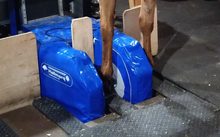Magnetic Resonance Imaging (MRI) is a relatively new type of imaging for horses. It works differently from x-rays and ultrasound by detecting abnormal tissue density and fluid in both soft tissue and bone based on the tissue response to magnetization.

MRI imaging of horse's foot
Magnetic Resonance Imaging is a relatively new type of imaging for horses since it works by detecting abnormal tissue density and fluid in soft tissue and bone based on tissue response to magnetization.
© 2018 by Virginia Tech EMC
In humans, it is used for almost all body systems to identify both bone, joint and soft tissues including the brain and spinal cord. This has revolutionized detection of disease by understanding the metabolism changes, which occur in different tissues with disease.
MRI for horses has been used for approximately 2 decades. Initially MRI studies could only be completed with horses under general anesthesia in high field units made for humans. In 2003 a low field open magnet was created by Hallmarq Veterinary Imaging for use in standing horses.
The Marion duPont Scott Equine Medical Center (EMC) installed the Hallmarq MRI in 2004. Since then, the predominate use has been for foot diseases, but with improved software images of the pastern, fetlock, cannon bone and knee are now possible if the horse stays still during image capture.
Horses need to be sedated so they can stand quietly in open magnet. The magnet moves so that the region of interest (ROI) is in the center of the magnet. Different image sequences are used to identify the different tissues and the abnormalities. This can take from 1-3 hours to get all the different image slices needed to see all the structures.
The greatest advantage of MRI in horses is the ability to detect damage to bones, tendons and ligaments that can’t be diagnosed in any other way. This is particularly true in the horse’s foot, which because of the hoof visualization of the soft tissue structures is limited.
Because MRI creates images in multiple slim slices, a 3-dimensional reconstruction can provide the exact location and severity of the injury.
The most common injuries in the foot are deep digital flexor tendinopathy, navicular bone inflammation, coffin joint collateral ligament desmopathy, bone bruises and joint distention.
These injuries can only be detected by MRI. Additionally, EMC has developed MRI guided injection techniques for injuries to the deep digital flexor tendon and collateral ligaments in the foot. This provides an accurate placement of platelet rich plasma (PRP) and stem cells to help treat these injuries.
Article by Nathaniel A. White, II DVM, MS, Diplomate ACVS, Professor Emeritus of Equine Surgery
The Marion duPont Scott Equine Medical Center is a premier, full-service equine hospital located in Leesburg, Virginia, and one of two hospitals of the Virginia-Maryland College of Veterinary Medicine. We offer advanced specialty care, 24-hour emergency treatment, and diagnostic services for all ages and breeds of horses.
Our team of equine specialists in internal medicine, reproduction, sports medicine and rehabilitation, and surgery is committed to providing exceptional treatment for patients; superior service to clients; education for referring veterinarians, future veterinarians, and clients; and cutting-edge research to the equine industry.
